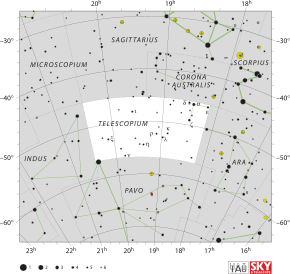
Back Teleskoop (sterrebeeld) Afrikaans المقراب (كوكبة) Arabic تيليسكپيوم ARZ Telescopium AST Teleskop (bürc) Azerbaijani Телескоп (йондоҙлоҡ) Bashkir Тэлескоп (сузор’е) Byelorussian Телескоп (съзвездие) Bulgarian Teleskop (steredeg) Breton Teleskop (sazviježđe) BS
| Constellation | |
 | |
| Abbreviation | Tel |
|---|---|
| Genitive | Telescopii |
| Pronunciation | /ˌtɛlɪˈskoʊpiəm/, genitive /ˌtɛlɪˈskoʊpi.aɪ/ |
| Symbolism | the Telescope |
| Right ascension | 19h |
| Declination | −50° |
| Quadrant | SQ4 |
| Area | 252 sq. deg. (57th) |
| Main stars | 2 |
| Bayer/Flamsteed stars | 13 |
| Stars with planets | 0 |
| Stars brighter than 3.00m | 0 |
| Stars within 10.00 pc (32.62 ly) | 2 |
| Brightest star | α Tel (3.49m) |
| Messier objects | 0 |
| Bordering constellations |
|
| Visible at latitudes between +40° and −90°. Best visible at 21:00 (9 p.m.) during the month of August. | |
Telescopium is a minor constellation in the southern celestial hemisphere, one of twelve named in the 18th century by French astronomer Nicolas-Louis de Lacaille and one of several depicting scientific instruments. Its name is a Latinized form of the Greek word for telescope. Telescopium was later much reduced in size by Francis Baily and Benjamin Gould.
The brightest star in the constellation is Alpha Telescopii, a blue-white subgiant with an apparent magnitude of 3.5, followed by the orange giant star Zeta Telescopii at magnitude 4.1. Eta and PZ Telescopii are two young star systems with debris disks and brown dwarf companions. Telescopium hosts two unusual stars with very little hydrogen that are likely to be the result of two merged white dwarfs: PV Telescopii, also known as HD 168476, is a hot blue extreme helium star, while RS Telescopii is an R Coronae Borealis variable. RR Telescopii is a cataclysmic variable that brightened as a nova to magnitude 6 in 1948.
It had been hypothesized in 2020 that Telescopium would also host the first known visible star system with a black hole, QV Telescopii (HR 6819), however observations in 2022 indicated that this is a binary system of two main-sequence stars without a black hole instead.
© MMXXIII Rich X Search. We shall prevail. All rights reserved. Rich X Search